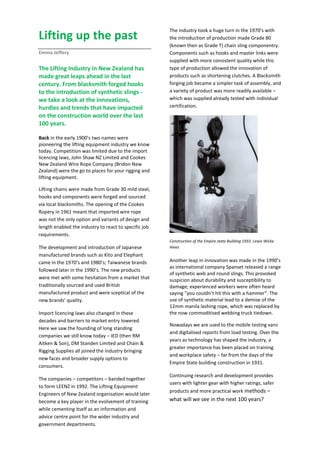
Leenz history article nov 11
- 1. The industry took a huge turn in the 1970’s with Lifting up the past the introduction of production made Grade 80 (known then as Grade T) chain sling componentry. Emma Jeffery Components such as hooks and master links were supplied with more consistent quality while this The Lifting Industry in New Zealand has type of production allowed the innovation of made great leaps ahead in the last products such as shortening clutches. A Blacksmith century. From blacksmith forged hooks forging job became a simpler task of assembly, and to the introduction of synthetic slings - a variety of product was more readily available – we take a look at the innovations, which was supplied already tested with individual hurdles and trends that have impacted certification. on the construction world over the last 100 years. Back in the early 1900’s two names were pioneering the lifting equipment industry we know today. Competition was limited due to the import licencing laws, John Shaw NZ Limited and Cookes New Zealand Wire Rope Company (Bridon New Zealand) were the go to places for your rigging and lifting equipment. Lifting chains were made from Grade 30 mild steel, hooks and components were forged and sourced via local blacksmiths. The opening of the Cookes Ropery in 1961 meant that imported wire rope was not the only option and variants of design and length enabled the industry to react to specific job requirements. Construction of the Empire state Building 1933. Lewis Wicke The development and introduction of Japanese Hines manufactured brands such as Kito and Elephant came in the 1970’s and 1980’s; Taiwanese brands Another leap in innovation was made in the 1990’s as international company Spanset released a range followed later in the 1990’s. The new products of synthetic web and round slings. This provoked were met with some hesitation from a market that suspicion about durability and susceptibility to traditionally sourced and used British damage; experienced workers were often heard manufactured product and were sceptical of the saying “you couldn’t hit this with a hammer”. The new brands’ quality. use of synthetic material lead to a demise of the 12mm manila lashing rope, which was replaced by Import licencing laws also changed in these the now commoditised webbing truck tiedown. decades and barriers to market entry lowered. Nowadays we are used to the mobile testing vans Here we saw the founding of long standing and digitalised reports from load testing. Over the companies we still know today – IED (then RM years as technology has shaped the industry, a Aitken & Son), DM Standen Limited and Chain & greater importance has been placed on training Rigging Supplies all joined the industry bringing and workplace safety – far from the days of the new faces and broader supply options to Empire State building construction in 1931. consumers. Continuing research and development provides The companies – competitors – banded together users with lighter gear with higher ratings, safer to form LEENZ in 1992. The Lifting Equipment products and more practical work methods – Engineers of New Zealand organisation would later become a key player in the evolvement of training what will we see in the next 100 years? while cementing itself as an information and advice centre point for the wider industry and government departments.